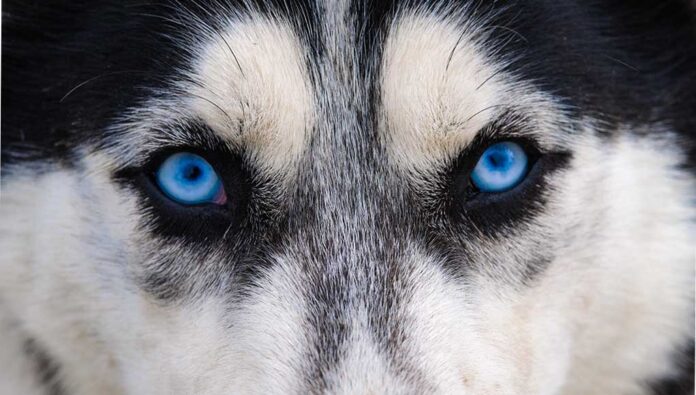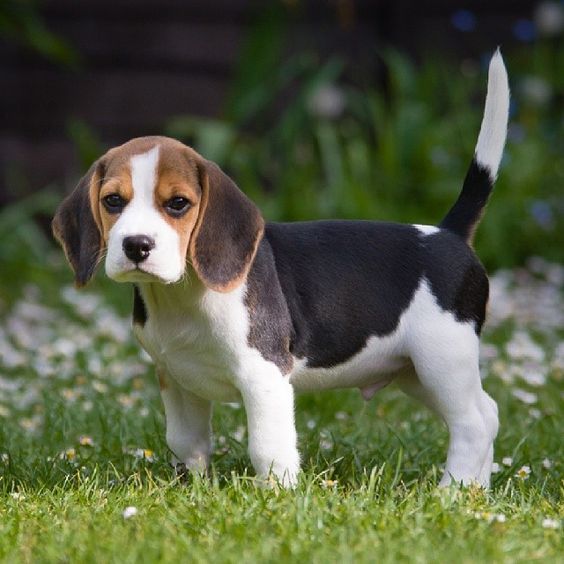Last Updated on August 18, 2021 by Fumipets
If you’ve ever seen a dog with blue eyes, you’re well aware of how fascinating and appealing the unique colour may be.
What is it about blue eyes that captivates us so much? Is it the amazing beauty of the colour that captures our attention, or is it the rarity of the colour that draws us in?
Despite the fact that blue eye colouring is considered undesirable in many breeds, many individuals looking for a distinctive pet want it.
How rare is it exactly? What causes it to happen in the first place? Which dog breeds are known to have this amazing trait?
We’ll go over all of that and more. But first, let’s take a look at some dogs that have blue eyes naturally, as well as those who have the potential to have blue eyes.
Five Common Dog Breeds with Natural Blue Eyes
While the following lists are by no means comprehensive, they will give you a sense of the broad range of breeds that may produce blue-eyed dogs.
1. Siberian Husky
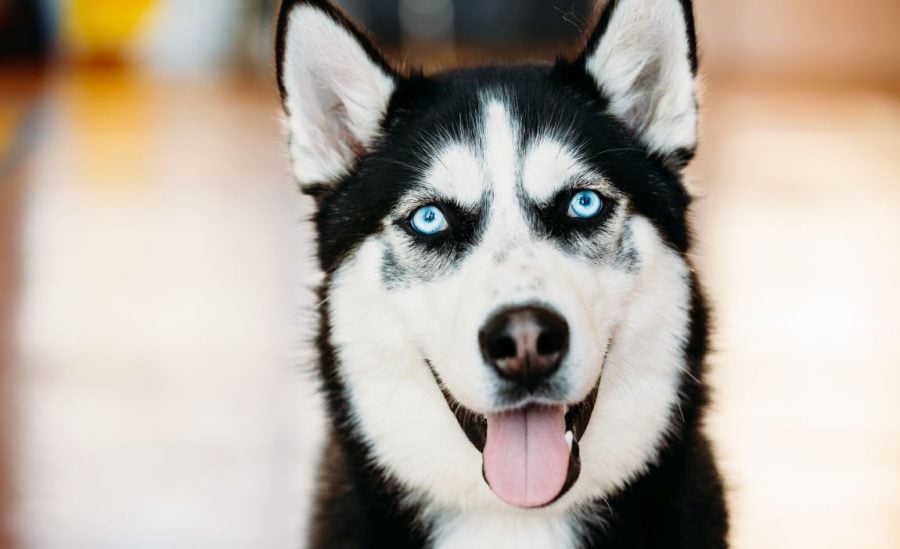
The gorgeous Siberian Husky is likely to spring to mind when you think of a blue-eyed dog, and for good reason.
Two out of every five Siberian Huskies is expected to have blue eyes, and 15% will have one blue eye and one brown eye.
Blue eyes may be inherited by Siberian Husky hybrids, such as the beautiful Pomsky (a cross between a Pomeranian and a Husky).
Siberian Huskies are loving, yet they have a reputation for being naughty.
They get along well with humans and other dogs, although they have a high hunting drive and may pursue small animals.
When walking a Husky, you should always use a firm leash and a snug collar, or even better, a robust harness. (In this post, we highlight the finest of the greatest.)
2. Australian Shepherd
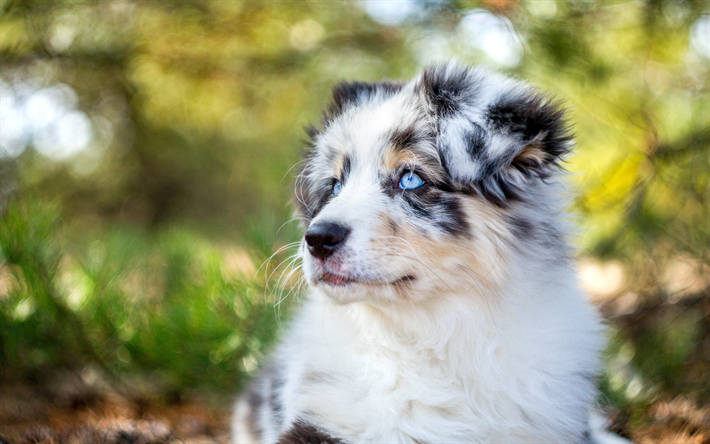
The Australian Shepherd is a herding dog, as the name suggests, but the Australian portion is a misnomer.
They really had their origin in Europe’s Pyrenees Mountains. Before the breed arrived in California, it was crossed with Collies and Border Collies (both from Scotland).
Merle pattern dogs often have blue eyes, which contribute to the appeal of this hardworking, nimble, and very active breed.
Mixes, like the ever-popular Aussiedoodle, may have beautiful blue eyes and shed far less than full-blooded Australian Shepherds.
Australian Shepherds (and mixes) need a lot of exercise on a daily basis due to their apparently limitless energy.
Games of fetch using heavy, hollow rubber toys that bounce unpredictably and can be tossed considerably further, can burn off these dogs’ energy more effectively than a normal tennis match.
3. Dalmatian
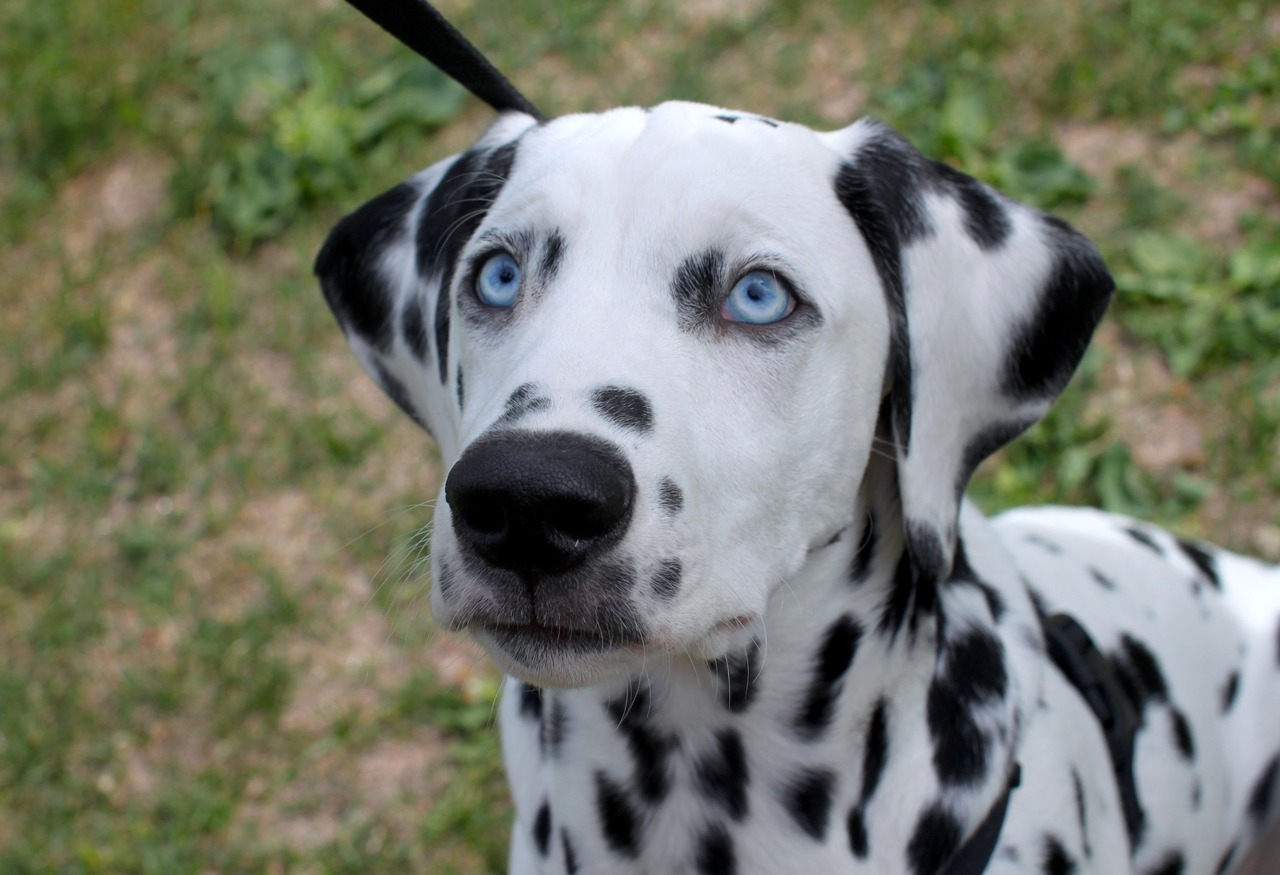
The Dalmatian, one of the most well-known breeds of all time, was initially bred to protect horses and carriages.
This breed is dignified in both look and attitude, and although distant with outsiders, he is completely at ease at home with his family.
This breed is known for its stunning blue eyes.
Unfortunately, gorgeous blue eyes aren’t the only thing this breed has in common. Approximately one-third of all purebred Dalmatians have some degree of hearing loss.
The problem is caused by a lack of melanin-producing cells (melanocytes) in the ear, and dogs with tiny, widely dispersed spots (the “perfect” Dalmatian markings) and blue eyes have the greatest rates of deafness.
4. Border Collie
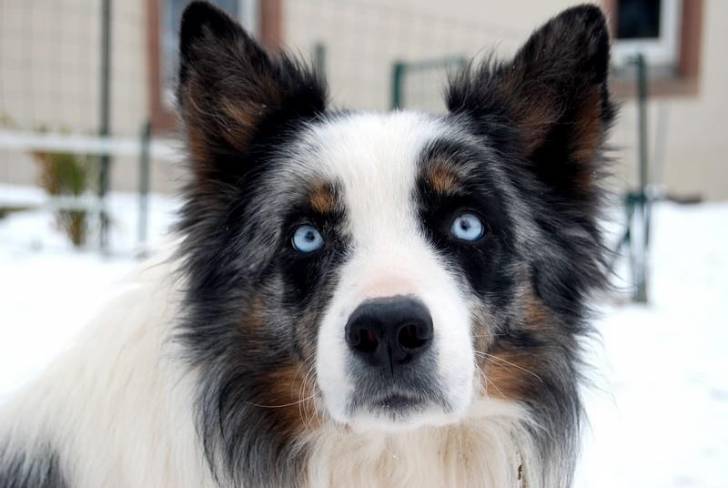
Border Collies are amazing to see in action because of their agile, stealthy movements and great concentration while performing what they were meant to do, which is herd sheep.
Their superior intellect, trainability, and athleticism make them champions in agility, flyball, obedience, and flying disc events, in addition to herding.
Owners may have a hard time keeping up with them and tyre them out due to their high activity levels.
Toys like this ball launcher, which let your dog do the most of the work while you sit back and watch the action, are perfect for extremely active, clever breeds like this one.
Border Collie breed guidelines allow for any eye colour, coat colour, or markings, so it’s no surprise that blue eyes occur often in the breed.
5. Catahoula Leopard Dog

The Catahoula Leopard Dog, along with spicy, thick gumbo, is one of Louisiana’s numerous claims to fame.
This breed is known for its unusual herding style. These dogs form a live fence around a herd in order to keep it in place for their owner.
These worker canines often have blue eyes of various hues.
Other Dog Breeds That Occasionally Produce Blue-Eyed Dogs
Cocker Spaniel

Blue eyes are possible in both American and English Cocker Spaniels with the merle pattern.
Despite the fact that the American Kennel Club (AKC) does not yet recognise merle or blue eyes as acceptable in any breed, they are a popular and in-demand feature.
The Cocker Spaniel is an ancient breed that evolved from Spaniel-type dogs that were employed for hunting as early as the 1300s.
Today’s Cocker Spaniels are lively and loyal, but they may be sensitive or shy if they are not properly socialised.
These intelligent, loving dogs are as at home in the home as they are in the field working with a hunter.
Alaskan Klee Kai

The Alaskan Klee Kai is a very young breed that has yet to be recognised by the AKC.
These dogs resemble the Alaskan Husky and the Siberian Husky in appearance since both breeds were utilised as foundation stock, although they barely weigh 10 to 20 pounds.
Blue is a common colour for one or both eyes, although brown, amber, green, and hazel are all common.
This breed is quick and agile, and when properly taught, can fly through an agility course with incredible speed and precision.
Because these dogs are cautious of strangers, training and socialisation are essential.
Beagle

Beagles have long been America’s most popular hound dog, according to the AKC.
It’s difficult to ignore their upbeat, loving demeanour and beautiful features. A person with unusual blue eyes is a rare find.
Beagles are still prized today for their tracking abilities and vocalisations, which include the normal bark, howl, and the notorious baying.
Because of their keen sense of smell, the US Department of Agriculture uses a squad of Beagles, known as the Beagle Brigade, to sniff out banned agricultural goods smuggled into international airports.
Old English Sheepdog

The Old English Sheepdog is one of only a few breeds that the American Kennel Club (AKC) does not penalise for having blue eyes or one blue and one brown eye.
These dogs were originally mainly employed to herd cattle, not sheep, despite their name. Their large shaggy coats were sometimes sheared and braided into yarn for clothes, which was ironic.
These shaggy dogs have a reputation for being tolerant and protective of their family, especially youngsters.
Don’t be misled by their ambling gate; these dogs will need plenty of exercise and fun on a regular basis.
They may frequently be seen burning off some of their energy and putting their intelligence to good use at agility, obedience, and rally competitions.
However, to maintain that shaggy hair tangle-free and flowing elegantly, it does need frequent care.
Special grooming equipment, like de-shedding tools, are necessary for removing loose hair and avoiding mats from developing near to the skin on coats.
Great Dane

Great Danes are surprisingly sociable, with an eager-to-please, easy-going disposition, despite their enormous size and weight.
Males may weigh up to 175 pounds and reach 32 inches tall at the withers, which is beneficial for owners.
The AKC permits blue eyes on harlequin and merle patterned dogs, and they come in a variety of hues and patterns.
Pembroke And Cardigan Welsh Corgi
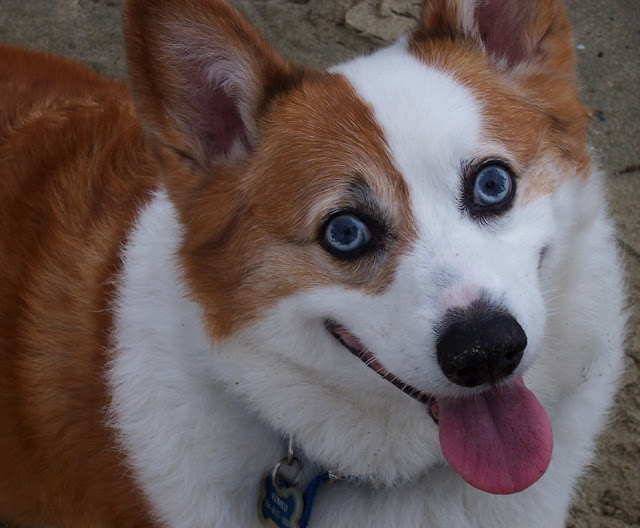
Although they were often interbred until the late 1800s, the Pembroke Welsh Corgi is considered a distinct breed from the Cardigans.
The ear form, which is pointed in Pembrokes but rounded in Cardigans, and the length of the tail, which is considerably longer in Cardigan dogs, are the main distinctions between the two breeds.
Blue eyes can be seen in both Welsh Corgi breeds, although the AKC only accepts them in blue merle Cardigans.
What these breeds lack in height (they stand between 10 and 12 inches at the withers) they make up for in personality.
They have a pleasant disposition and are both loving and sociable.
Shetland Sheepdog
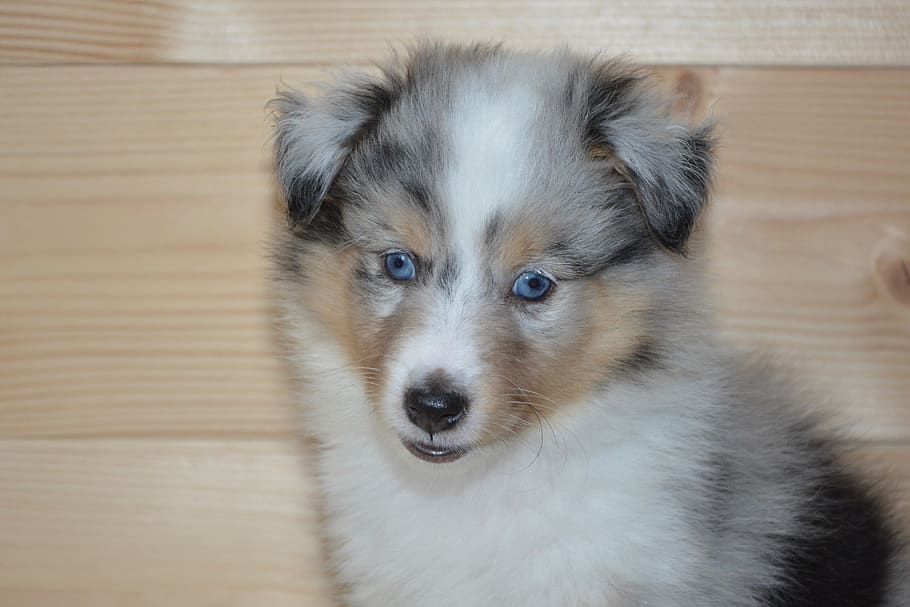
Shetland Sheepdogs, which resemble Collies but are considerably smaller, thrive in a variety of canine sports, including agility and herding competitions.
Only three colours are recognised by the AKC: black, blue merle, and sable, each with white or tan markings permitted, and blue eyes are permitted in dogs with a blue merle coat.
Shelties, with their remarkable intellect and loyal disposition, adapt well to training.
Because of their willingness to bark at the first indication of danger and their natural distrust of strangers, these alert dogs are often employed as watchdogs (rather than guard dogs, since they are too tiny to be threatening).
Great Pyrenees
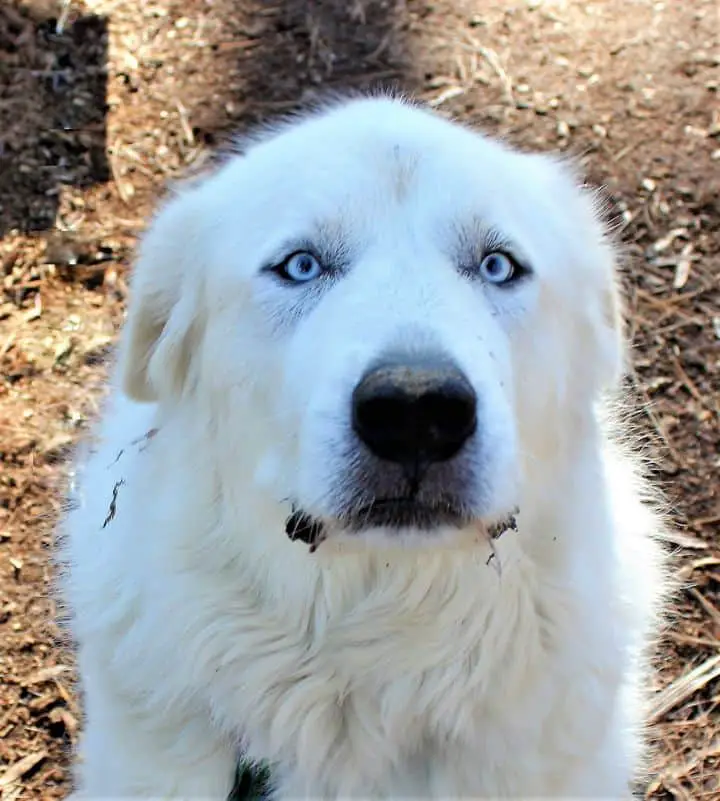
The dazzling white Great Pyrenees have been admired for generations because of their magnificent beauty and peaceful, patient temperament.
This breed is known for its tremendous strength, bravery, and calm demeanour, and was formerly employed to protect flocks and repel predators (both four-legged and two-legged thieves).
Blue eyes are not allowed in the breed standard, although they do exist and look stunning against the rich white coat.
American Pit Bull Terrier

American Pit Bull Terriers, despite their unfair image, are extremely friendly dogs.
They were formerly known as the “All-American dog,” and they appeared in many ads during World Wars I and II.
Blue eyes are seen in this breed on occasion, particularly in dogs with blue coats and noses and those with merle patterning.
(Blue Nose Pit Bulls are an uncommon breed, but they are undoubtedly beautiful.)
They aren’t violent by nature, but they may be severe chewers, and some solid chew toys will satisfy their powerful jaws.
Although the American Kennel Club (AKC) does not recognise American Pit Bull Terriers as an official breed, the United Kennel Club (UKC) does, and the UKC was established specifically to register these clever, kind dogs.
Boxer

Boxers got their name from their proclivity to use their front feet during play or while protecting themselves, much like a human boxer.
Due to a recessive trait, blue eyes have appeared in fawn, brindle, and white (not an acceptable colour for the show ring) dogs.
Boxers are renowned for being devoted, clever, courageous, lively, and excellent with children, but appropriate socialisation should not be overlooked when they are pups.
Australian Cattle Dog

Australian Cattle Dogs were developed by deliberately breeding Smithfield dogs (now extinct) with wild Australian Dingoes, Collies, and Dalmatians in order to make the ideal herding dog.
Puppies have a white coat that gradually becomes blue-grey or crimson. While the breed standard specifies dark brown eyes, blue eyes are sometimes seen.
These very clever canines are extremely active and flourish when they are physically and intellectually pushed on a regular basis.
Weimaraner
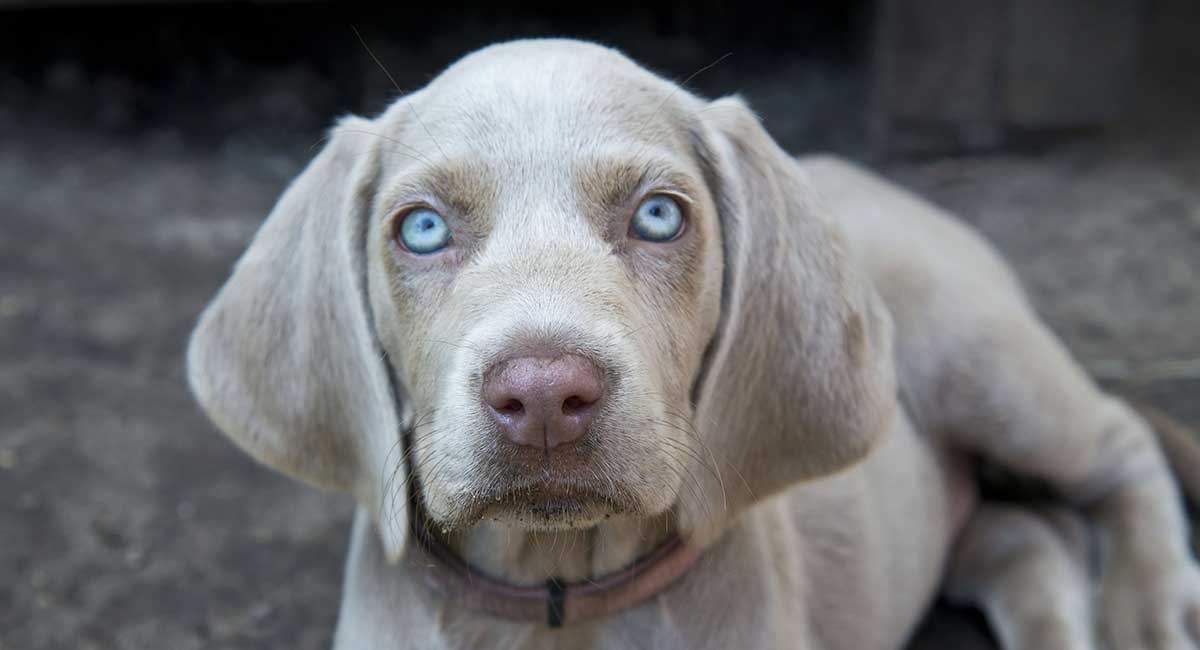
The beautiful Weimaraner, which is sometimes mistaken for a Labrador or a Vizsla, was created in Germany in the early 1800s as a big-game hunter and subsequently as a gamebird pointer and retriever.
When blue eye colouring does appear, it is usually a bluish-grey colour rather than a deep blue.
Due to his silver-grey coat colouring and propensity to constantly stay beside his master, the Weimaraner is often referred to as the Gray Ghost.
Unless you’re a tiny, fluffy creature, this loyal breed is renowned for its high activity needs and lovely demeanour.
Basset Hound

The mournful-looking Basset Hound, which was developed in France and Belgium for outstanding hunting tracking skills, is now the AKC’s 39th most popular canine.
The tiny little legs of a Basset Hound are powerful and designed for endurance.
These dogs are not as sluggish as they seem, but they do have a tendency to be stubborn.
Blue eyes are common in merle-patterned dogs, but they are considered a severe flaw in the show ring.
Mastiff

After seeing the huge Mastiffs during an invasion of Britain in 55 B.C., Julius Caesar was immensely impressed, according to his journal.
Due to their enormous size (up to 230 pounds) and intimidating look, they are still a force to be reckoned with today.
Mastiffs and allied Mastiff breeds such as the Bull Mastiff, Neapolitan Mastiff, and Tibetan Mastiff produce blue-eyed puppies on occasion.
Shih Tzu

Shih Tzu is a Chinese word that means “lion dog.” That’s a big name to bear for such a little dog, but they appear to be doing well.
This beautiful species originated in China as pampered royal lap warmers in emperor’s palaces and is said to be at least a thousand years old.
The coat occurs in a variety of colours, and blue-coated dogs, although uncommon, often have blue eyes.
American Staffordshire Terrier

Amstaffs (short for American Staffordshire Terriers) are derived from Old English Bulldogs that were crossed with Terriers to improve their rat-baiting abilities.
They are devoted, athletic, self-assured, and patient with youngsters, making them excellent family pets.
Colours, coat patterns, and eye pigments vary greatly among Amstaffs.
Brown, amber, hazel, green, and blue eyes are common, but nothing quite adds to the mystique of this powerful yet loving dog like a beautiful set of baby blues.
Rottweiler
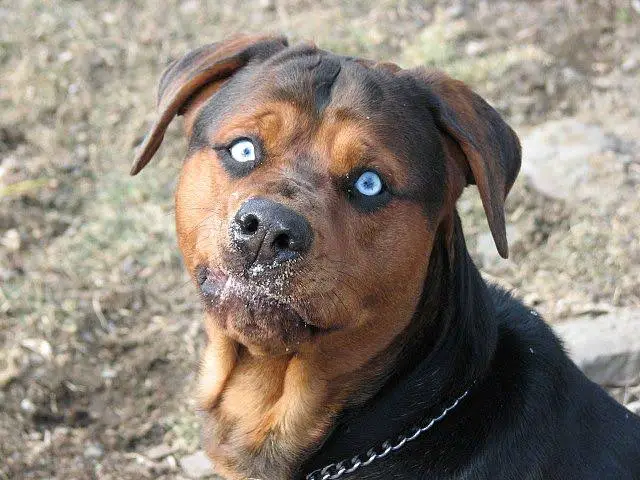
Heterochromia is a disorder in which certain Rottweilers are born with either two blue eyes or one blue eye and one brown eye.
These powerful, muscular dogs have a well-deserved reputation as great guard dogs, but when properly trained and socialised, they can make wonderful friends.
Rottweilers have been employed widely in both police and military service, and have been known to thrive as therapy dogs, search and rescue dogs, and guide dogs owing to their high intelligence and trainability.
Bergamasco Sheepdog

Bergamasco Sheepdogs are renowned for their one-of-a-kind coat consisting of long, matted, felted hair called flocks, which was formerly used to lead and guard sheep in the Italian Alps area.
Blue eyes are a disqualification in this breed according to the AKC (though merle colour patterns are permitted), yet they may and do occur.
This breed is intelligent and has a calm, balanced temperament.
They are powerful and courageous, and will naturally keep an eye on their family, much as they used to do with their sheep herds.
Their kind and loving attitude balance out their little inclination to be independent.
What Does It Mean For A Dog To Have Blue Eyes?
Without going too far into the huge and perplexing realm of genetics, let’s look at the four major reasons why dogs are born with blue eyes rather than the more common brown.
Merle Gene
By diluting random portions of the coat and skin to a lighter colour, the merle gene is responsible for mottled or uneven patches of colour in the coat and on the skin.
Blue eyes are a common side effect of the dominant merle gene, but not every merle dog will have them.
The suppression, or dilution, of melanin inside the iris, causes the blue eye colour.
The more colour dilution there is on a dog’s body, the more likely it is that the youngster will have blue eyes.
Dogs with merle patterns are usually as healthy as their solid-coloured counterparts, but double, or homozygous, merles are a different storey.
When two merle dogs are crossed, the offspring will receive the dominant merle gene from both parents, hence the name “double merle.”
Because of the absence of pigmentation in critical places, double merles are prone to blindness, deafness, skin cancer, and severe sun sensitivity.
Intentionally breeding two merle dogs to produce a litter with numerous, severe health issues is considered unfair and cruel.
:max_bytes(150000):strip_icc()/GettyImages-1000997298-c7990ef7211144d6bc616a27a2e7d45c.jpg)
Blue Eye Gene
A dominant blue eye gene exists in a few dog breeds, including the Siberian Husky and the Border Collie, that is independent of coat colour.
Blue eyes (or only one blue eye — a condition known as wall eye) range from a pale, almost white-blue to a deep sky blue in dogs that receive this gene.
This gene has no effect on the colour of the nose or coat.
Many breeds, like the Pembroke Welsh Corgi and the Beagle, contain a recessive blue eye gene that, although present, isn’t as common as the dominant form.
Pigmentation Deficit Around The Eyes
Because of the obvious absence of pigmentation in that location, canines born with significant patches of white on the face, especially around the eyes, will often have blue eyes.
This is the most frequent cause of blue eyes in dogs that are mostly white.
Blue-eyed dogs, which are the consequence of a lack of face pigmentation, are not albinos. They have the ability to produce melanin, while albinos do not.
Albinism
True albinos are very uncommon and are defined by a total absence of melanin (the pigment that gives skin colour) and the enzymes that generate it.
Though only genetic testing can identify pure albinos, a careful visual examination will show a lack of pigmentation across the whole body, resulting in a coat that looks white but is really colourless.
The skin, nose, eyelids, irises, and tissue surrounding the eyes will all be a pale pink colour. That pink is really a loss of colour that only looks pink because of blood flow under the skin.
So, what does being blue-eyed have to do with any of this?
Complete albinism is very uncommon, while partial albinism is somewhat more frequent.
True albinos are dogs born with the capacity to generate even the tiniest amount of melanin.
While they exhibit albino features like pink noses and large regions of pigmentation loss, they usually have bright blue eyes.

Can Any Dog Breed Have Blue Eyes?
Most dog breeds are theoretically capable of producing children with blue eyes due to the many distinct genes and their accompanying mutations and variances, various additions to lines that occurred many years ago, and the recessive blue eye gene, but this is an uncommon occurrence in many breeds.
Are blue-eyed dogs are more prone to health problems?
Many people question whether having blue eyes in a dog is a negative thing. A blue-eyed dog’s sole significant health problem is an enhanced sensitivity to strong light and sunshine.
In comparison to darker eyes, blue eyes have a lesser concentration of melanin in the irises. More light passes through to the retina without the protection that greater concentrations of melanin offer, resulting in squinting and discomfort.
The bulk of health issues with blue eyes in dogs are focused on double merle canines. Eye abnormalities in double merles are common at birth, leading to blindness.
They often lack essential pigmentation in the inner ear, resulting in the death of some sensory nerve cells. Deafness in one or both ears is the consequence.
Double merles are also more prone to develop skin cancer on the nose and other parts of the body where pigmentation is lacking.
Disorders That Can Cause The Eyes To Turn Blue
While all puppies have blue eyes at birth, most pups’ eyes will change colour between the ages of 4 and 16 weeks, progressively becoming brown, hazel, or green depending on the quantity of melanin generated.
The eyes of some dogs do stay blue for the rest of their lives. Blue colouration will be vivid and clear for canines in this group.
A dog’s eye colour does not change spontaneously when it develops a blue tint or a hazy look as an adult.
Rather, they’re suffering from one of many eye conditions.
Any time a noticeable change in the eye is observed, it’s important to contact your veterinarian immediately soon so that a treatment plan can be put in place.
The following are common reasons for a blue tint in one or both eyes in an elderly dog:
- Cataracts.
- Nuclear sclerosis.
- Glaucoma.
- Stromal corneal dystrophy.
- Anterior uveitis.
- Hepatitis blue eye.

